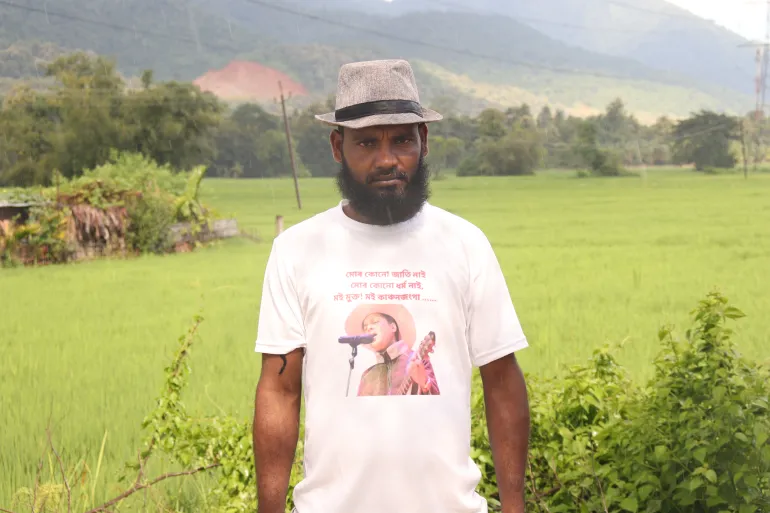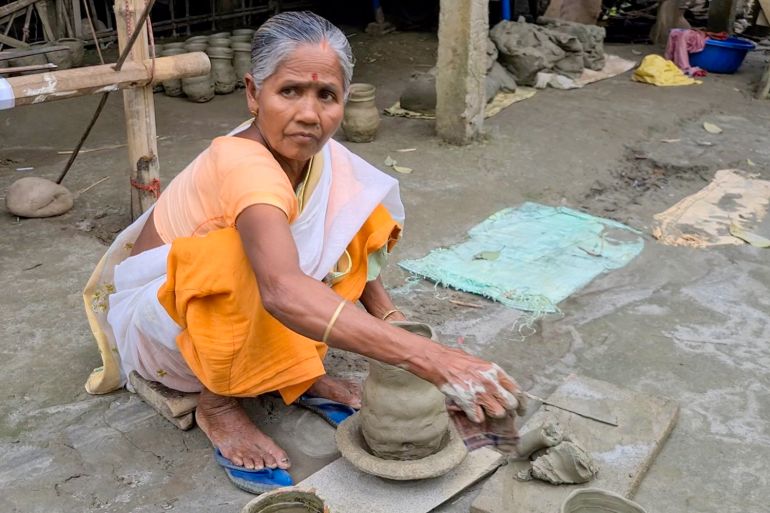‘Zubeen was for all’: Singer’s death unites India’s religiously torn Assam | Politics News
Barpeta/Guwahati, Assam, India – For more than 15 years, truck driver Imam Hussain found solace in singer Zubeen Garg’s voice and music as he drove his vehicle on quiet and lonely nights along the Himalayan hills and plains of the northeastern Indian state of Assam.
It was a period in which Bengali-speaking Muslims – the community 42-year-old Hussein belongs to – increasingly came under attack in Assam. They’ve been accused of being outsiders – even infiltrators – in their own home.
Amid soaring Hindu-Muslim tensions, the music of Garg – a Hindu – served as a rare unifier. “His music was my inner peace,” said Hussain.

On September 19, Garg died by drowning near Lazarus Island in Singapore, where he was scheduled to perform at the Northeast India Festival, an event that celebrates the art and culture of the Indian region.
The sudden death of the 52-year-old artist, who enjoyed a cult-like status among millions of his fans in and outside Assam, triggered a massive outpouring of grief that further cemented his stature as a public figure whose appeal spanned divisions that have otherwise fractured the state. The singer’s wife, Garima Saikia Garg, issued a statement, saying her husband “suffered a seizure attack” while swimming in the sea.
While Hussain was mourning Garg’s death, so was Prime Minister Narendra Modi, whose Hindu majoritarian Bharatiya Janata Party (BJP) is accused by critics of fanning Hindu-Muslim divisions nationally and in Assam.
“He will be remembered for his rich contribution to music,” Modi said in a condolence message. “His renditions were very popular among people across all walks of life.”

Assam’s Chief Minister Himanta Biswa Sarma, who belongs to Modi’s party, said the state “lost one of its favourite sons”.
“Zubeen’s voice had an unmatched ability to energise people, and his music spoke directly to our minds and souls. He has left a void that will never be filled,” Sarma said.
The Assam government declared four days of state mourning as Sarma flew to the capital, New Delhi, to receive Garg’s body when it returned from Singapore.
A polarised backdrop
Two days later, on September 21, tens of thousands of Garg’s fans gathered outside the main airport in Guwahati, Assam’s biggest city. They waited as state officials received Garg’s body after it landed.
Then, they marched behind a convoy carrying the body to a stadium some 30 kilometres (19 miles) away for public viewing, singing some of his most famous songs in unison. Some held his posters, while others walked teary-eyed with candles in their hands. After four days of state mourning, Garg was cremated on September 23 with full state honours and a 21-gun salute.
Those scenes of unity were a break from the religious and linguistic fractures that have deepened in Assam in recent years.

The fault lines between the Indigenous Assamese-speaking and the mostly migrant Bengali-speaking communities in Assam aren’t new: They go back nearly two centuries, when the British brought large numbers of Bengali-speaking Hindus from Bengal to run the colonial bureaucracy, creating resentment among the Indigenous Assamese who feared the outsiders would take their jobs and occupy lands.
A second wave of migration of Bengali-speaking Hindus and Muslims to Assam started in 1947 with India’s independence and the formation of Pakistan, which included the territory that in 1971 declared itself the independent nation of Bangladesh. Millions of people migrated from Bangladesh to Assam in these years, triggering backlash from the Indigenous Assamese, which often turned violent.
Those ethnic and religious tensions continue to dominate Assam’s politics even today as suspicions over the identity and citizenship of mainly Bengali-speaking Muslims – pejoratively called “miya” – deepen, with thousands of them declared “Bangladeshi infiltrators” and many of them sent to detention camps or forced to cross over to Bangladesh by Indian security forces.
Garg was composing his music against this polarised backdrop, responding to the communal fissures with his verses and voice.
On many occasions, the singer described himself as an atheist and a “social leftist” as he distanced himself from the state’s mainstream parties, the centrist Congress and the right-wing BJP.
He was also a vocal critic of India’s deeply entrenched caste system.
In an undated video now viral after his death, a person on stage is seen teasing Garg for not wearing the sacred thread worn by other Brahmins, who sit at the top of Hinduism’s complex caste hierarchy.
Garg shot back, saying, “I am just a human. I have no caste, no religion, and no God.”
In another instance, Garg in 2018 encouraged famous female Assamese Olympian, Hima Das, to consume beef in order to “gain strength” to compete in international and national sports events. Many Hindus belonging to privileged castes revere the cow, and its slaughter and consumption are banned in several Indian states. It is unclear whether Das accepted Garg’s advice.
He was also at the forefront of a 2019 campaign against India’s controversial new citizenship law, which made religion a basis for expediting citizenship for immigrants from neighbouring nations, excluding Muslims. The law led to nationwide protests against Modi’s government, while the United Nations called it “fundamentally discriminatory” and urged a review.
Assamese social media creator Dr Medusssa told Al Jazeera that as anti-Muslim hate permeated Assamese society, Garg’s public positions stood out, turning him into an emblem of Hindu-Muslim harmony.
“It is precisely because of Zubeen’s persona of being inclusive, and how he represented marginalised communities through his songs, that his legacy is being claimed by all,” said Medusssa, who requested to be identified by her social media name.
“He refused to belong to any particular community. He was for all.”
For Akhil Ranjan Dutta, a political scientist at Gauhati University in Assam, the celebration of Garg by Modi and Sarma – despite the dissident artist’s opposition to Hindu majoritarianism – is partly due to the way the singer approached the politics of dissent.
“While he [Garg] would openly criticise the policies and the actions of the federal and state-level BJP governments, he would seldom attack BJP leaders [personally],” Dutta told Al Jazeera. “This makes it easier for the BJP to appropriate his legacy as not mourning him would otherwise put them under public scrutiny.”
Another political commentator who did not wish to be named – fearing reprisal from the government – was more blunt in his view of Garg’s ability to bridge political divisions.
While Garg was dismissive about the BJP as a political party, “he would not rattle their nerves by criticising their anti-Muslim policies or the attacks on Muslims very openly”, the commentator said. “That way, the Hindu nationalist party never feel too alienated by him.”
‘Artistic tour de force’
Born in 1972 to Assamese writer Mohini Mohan Borthakur and singer Ily Borhakur in Assam’s Jorhat town, Garg began singing at the age of three and was soon regarded as a child prodigy by his teachers. He moved to Guwahati to build his career as a singer and got his first major breakthrough in 1992 with the release of his debut Assamese album, Anamika.
It was the beginning of an illustrious career that saw Garg singing more than 38,000 songs in dozens of languages and dialects. He also sang several songs for Bollywood films, bursting into the national scene in 2006 with his Hindi hit, Ya Ali, for the film Gangster: A Love Story.
The next year, Garg won the national award for composing songs for the non-feature film, Echoes of Silence. Affectionately known as Zubeen Da among other sobriquets, he later ventured into acting and direction.
But more than Garg’s body of work, says Angshuman Choudhury, a joint doctoral candidate at the National University of Singapore and King’s College London, what made him a musical phenomenon was his refusal to conform to the archetype of a “tamed” and “cultured Assamese artist”.
The state’s popular culture, for the most part, according to Choudhury, was shaped until the 1990s by artists like musician Bhupen Hazarika and singer Janyata Hazarika, who “respected norms of social civility, never deviated from the script, and lacked the audacity to be that iconoclast that Garg was”.
“Garg, on the other hand, was an artistic tour de force in Assam. He disrupted and distorted the very image of a public performer and artist,” says Choudhury, whose doctoral research focuses on the ethnicity and politics of northeast India.
“He would use verbal expletives while on stage, sing under intoxication, and on many occasions, show overt defiance against established norms and culture.”
For instance, he once refused to perform at an event to mark Bihu – arguably Assam’s most important festival – after the organisers said that he could not sing in Hindi.
Prithiraj Borah, a sociologist from Assam who teaches at the National Academy of Legal Studies and Research in Hyderabad, said that Garg’s art also touched deeper, emotional and philosophical questions.
“Zubeen’s songs did not merely entertain,” he told Al Jazeera. “They also addressed the depths of what it means to be human, to love, to suffer, and to find meaning in an often-absurd world.”
Borah cites Garg’s song, Pakhi Pakhi Ei Mon (My heart is like a feather), in which he explored themes of freedom and captivity.
“The feather becomes a metaphor for the human condition, caught between the desire for liberty and the reality of various constraints,” Borah said.
Accessible to all
Abrar Nadim, a health officer in Assam’s Barpeta district, says he has memorised most of Garg’s songs since he was four.
“His song, Aei Mayar Dhorat [In this world of earthly pleasures] brought me closure to spirituality,” said Nadim, 30, as he stood next to a garlanded poster of Garg, while wearing black in mourning.
“The song describes temporary happiness in this world where corrupt people enjoy even after committing acts of injustice, corruption, and oppression, but little remains in the end.”

Maitrayee Patar, a prominent Assamese songwriter and poet, who had collaborated with the singer, including as recently as in 2023, said Garg, as an artist, “exuded a humanitarian side that was raw and relatable to all”.
“He disregarded political correctness and refused to align himself with majoritarian politics or any political parties, which made [him] come across as an artist loved by all,” Patar told Al Jazeera.
As clips from Garg’s songs and old interviews flood Assam’s social media, Hussain, the Bengali-Muslim truck driver in Guwahati, says his staunch rejection of hate politics and his humility in treating everyone as equal made him accessible to all.
Garg was Hindu. But after his death, students in madrasas – Islamic schools – were seen playing his songs, while Muslim leaders held prayers in his honour and recited the Quran before his photos – grieving practices not typically allowed by Islamic tenets.
“He [Garg] sang jikir – devotional folk songs sung by the Assamese-speaking Muslim community – to honour us,” Nadim said. “So there is nothing wrong if we pray for him by singing his songs.”
Back in Guwahati, truck driver Hussain recalled how Garg “never vilified” Bengali-speaking Muslims, as he wore a T-shirt bearing Garg’s photo.
Hussain hummed Garg’s iconic 2007 hit, Maya (Illusion) – a song in which the singer likens chasing a love interest to an illusion. The soothing melody, Hussein said, reminded him of the void left by the Garg’s death.
In Garg’s music, the idea of an Assam for Hindus and Muslims, Assamese speakers and Bengali speakers alike, was not an illusion.






